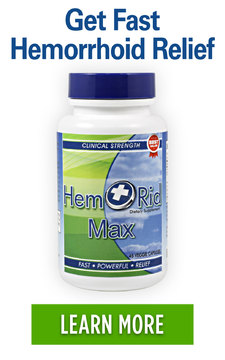Why Do Piles Hurt So Much? Are Piles Dangerous for My Health? Discover the Truth
Posted on 17 September 2018 by Maryanne Johnson
Share this post
Why in the world do piles hurt so badly? Are you in severe piles pain? You probably don't think much about your rectal veins, but when discomfort from your anorectal area arises and begins to inhibit daily activities, you may begin to wonder what's going on "down there."
The lowest part of the rectum has a network of sensitive veins intertwined with vital arteries, blood vessels, muscles, and tissues that all work to circulate the blood.
The Symptoms of Painful Piles
When classic symptoms of twinges of pain, sudden itching that ranges from moderate to intense, a rectal burning sensation, or anal masses begin to appear, then these signs are a good indication that you may be experiencing piles.
Piles are a term used when the rectal veins become swollen and inflamed because the supply of blood is hindered somehow. Formally, piles are known as hemorrhoids.
Learning what piles are can be upsetting, especially for people who have never heard about this common anorectal disease before or do not know the full scope of what it is, but piles are not considered to be a dangerous or fatal condition.
Hemorrhoids are so common that about half of the population will eventually develop them in their later years, around age fifty and older.
Piles can come and go. For a week or so, you may experience the typical symptoms of piles, and then notice that the symptoms have subsided, either by themselves or with the aid of various topical treatments like creams, wipes, or suppositories.
Returning piles mean that your diet, lifestyle, or another reason is hindering the venous pathways to allow for a steady flow of blood to reach the lowest part of the rectum.
Why Do Piles Come Back:
- You are obese
- You are over the age of fifty
- Chronic bowel issues like constipation or diarrhea
- Straining during defecation
- Straining while engaging in heavy lifting
- Sitting and standing for lengthy periods of time
- Gastrointestinal disorders
- Lack of hydration
- The absence of a fibrous diet
- Lack of exercise
- You are pregnant
- Post labor and delivery
Any number of these factors can place unwanted pressure on the rectal veins, forcing them to swell and lead to the development of hemorrhoids. Some variables can be changed, beginning with altering your diet and lifestyle to a healthier one.
The exact cause of hemorrhoids is still unknown, however. Research has shown us that the columns of rectal vascular tissues inflame because of impeded blood flow, but this could be attributed to several reasons.
One being humans walking upright, the tissues weakening as we age, or when the rectal muscles strain for any number of reasons (most commonly it is due to constipation from difficulty to pass stools, and a lack of fibre is genuinely to blame).
Common Complications of Piles
Despite piles being a non-threatening disease, it should still be addressed. Complications can develop from consistent and frequent piles. While these complications are not dangerous, they enhance symptoms and further disrupt daily life.
Complications of Piles Include:
- A blood clot (thrombosed haemorrhoid)
- A prolapsed haemorrhoid
The two types of hemorrhoids have their unique complications to accompany them. For external piles, the more painful of the two types, a blood clot can form inside the pocket of the already inflamed rectal vein, beneath the surface of the skin.
Blood clots, or what is known as a thrombosed hemorrhoid, are not typically dangerous, but if they rupture, you could get an infection that sets inside the open wound.
And with this being your rectal area, there is more of an exposure to faecal matter, mucus, and anal discharge.
External hemorrhoids sometimes make it harder for the person suffering from them to clean the rectal area due to the increased sensitivity and pain, further increasing a chance of infection if a thrombosed hemorrhoid were to open.
If you have external piles, you may notice lumps that are sore, tender, and painful. These masses tend to form around the anus or nearby, and you may have one or two at a time.
A particularly bad case of external hemorrhoids may introduce enlarged masses with strong symptoms of pain and throbbing.
Painful Thrombosed Piles
Without a blood clot, the lumps may look reddened and fleshy, and rubbery to the touch. A thrombosed hemorrhoid will be bluish because of the collecting blood beneath the skin, and sometimes even purplish.
A blood clot will produce sharp pain that is notably worse than that of a normal external pile.
Internal hemorrhoids introduce a whole other set of complications. Doctors categorize internal piles into stages known as degrees or grades.
The degrees indicate the increasing state of prolapse, meaning the severity of the hemorrhoidal column protruding through the rectum.
For milder cases of internal hemorrhoids, there could be no prolapse at all, or very little, in which the base of the hemorrhoidal column can be guided back through the rectum, gently with the fingers.
As the degrees progress, the columns of protruding piles can no longer be pushed back through manually and require a more intensive surgery to resolve the issue.
Even with these complications present for either type of hemorrhoidal issue, hemorrhoids are still not considered to be a dangerous or life-threatening health concern.
External and internal piles are uncomfortable, painful, and frustrating to daily life, yes, but this condition is more an indication of a need to make slight changes in the diet or lifestyle.
Severe Piles Pain
For severe cases, invasive surgeries may be recommended if conservative treatments fail to resolve piles.
For any operation that requires anesthesia, it could be considered intense and sometimes dangerous due to the increased risk of side effects following surgical procedures.
Piles Surgery
If complications are not reported immediately to the doctor following the procedure, they could worsen and may require the patient to be sent to the hospital for aftercare.
The most common surgery for extreme cases of piles is called a hemorrhoidectomy, where the surgeon removes the hemorrhoidal columns completely. A stapled hemorrhoidectomy has a similar approach but cuts off the supply of blood to force the hemorrhoids to shrink and fall off.
For both procedures, the recovery process can be trying, and the patient can experience rectal bleeding, difficulty using the bathroom, and pain. There is also no guarantee the piles will not return, which is significantly true if the patient does not make an effort to change their diet or habits.
Making Changes to Prevent Piles
If anything, piles are a reminder that your diet may not include enough fibre, and this is especially the case if you find that you are having trouble passing stools, straining on the toilet, or are not as regular as you need to be.
Piles are not dangerous for your health, but they can be a sign to show you that you could be doing better with either your diet or lifestyle.
Adding more fibre into your diet can cut down the frequency of piles.
For factors, you cannot control, such as your age, if you are pregnant, or just went through delivery, striving for a more fibrous diet can help counteract the pressure placed on the rectal veins, creating a higher risk of piles.
In many cases, additional fibre is more effective than other methods of treating piles.
How to Stop Painful Piles
There are options for temporary relief of symptoms, too. Balms, salves, ointments, and topical creams can do wonders for anyone suffering from the painful lumps of external piles and even target the annoying symptom of anal itch.
Suppositories have shown to be useful in many patients and taking supplements designed to relieve piles also have produced positive results.
In culmination with a proper diet, exercise and drinking plenty of water are also equally as important.
Exercise, as you likely are already aware, improves circulation, something that your rectal veins rely on to supply the lowest part of the rectum with rich blood.
Hydration contributes to the stool’s moisture content, and a stool with higher water content is much easier to pass than one without.
For anyone with the symptom of rectal bleeding, a visit to your GP is necessary. Rectal bleeding is typically an indication of internal piles, but your GP may want to pursue additional examinations to ensure that the rectal bleeding is not a symptom of a separate gastrointestinal issue.





0 comments